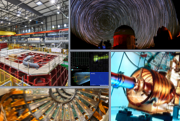Conveners
R & D
- Petra Merkel (Fermi National Accelerator Laboratory)
Tyler Rehak
19/06/2018, 14:00
Oral Presentation
As the Deep Underground Neutrino Experiment nears construction, the existing neutrino facilities at Fermilab provide opportunities to test and refine methods characterizing high precision neutrino beams. MARGARITA is a water Cherenkov stopped muon detector that features twin photomultiplier tubes and two small, slightly differing detector volumes. The two detector volumes are designed to...
Tanaz Angelina Mohayai
(Illinois Institute of Technology)
19/06/2018, 14:15
Oral Presentation
The Muon Ionization Cooling Experiment (MICE) at Rutherford Appleton Laboratory, an important R&D step towards a future muon collider or neutrino factory has studied ionization cooling of muons. Several million individual muon tracks have been recorded passing through a series of focusing magnets and a liquid hydrogen or lithium hydride absorber in a variety of magnetic configurations....
Xiaobin Lu
(Oak Ridge National Laboratory, The University of Tennessee, Knoxville)
19/06/2018, 14:30
Oral Presentation
PROSPECT is a short-baseline reactor-based antineutrino experiment designed to precisely measure the $^{235}$U antineutrino spectrum and search for oscillations due to the existence of an eV$^2$-scale sterile neutrino. Deployed at the High Flux Isotope Reactor (HFIR) at Oak Ridge National Laboratory (ORNL) in early 2018, the optically segmented 4-ton $^{6}$Li-loaded liquid scintillator...
Hunter Sullivan
(The University of Texas at Arlington)
19/06/2018, 14:45
Oral Presentation
The LArIAT (Liquid Argon In A Test Beam) experiment at Fermilab's Test Beam Facility exposes a Liquid Argon Time Projection Chamber (LArTPC) to a charged particle test beam in order to calibrate and characterize LArTPCs response. This is a perfect environment in that particle species and momentum can be preselected while event reconstruction tools, particle identification algorithms, and new...
Mr
Cory Rude
(CERN/Fermilab)
19/06/2018, 15:00
Oral Presentation
A crucial component of scintillators in current and future collider experiments is their ability to operate after exposure to radiation. The University of Iowa HEP group is developing scintillators for use in both HEP and medical fields. This talk will focus on our progress so far.
Grace Cummings
(University of Virginia)
19/06/2018, 15:15
Oral Presentation
Measurements in particle physics often rely on measuring the light produced in particle interactions with detector materials. Highly sensitive and fast detectors are frequently required. This is frequently accomplished with the use of Silicon photomultipliers (SiPMs), a type of avalanche photodiode operated in Geiger-mode (GAPD) with high detection efficiency and single photon resolution...
Mr
Zhaodi Pan
(The University of Chicago)
19/06/2018, 15:30
Oral Presentation
Fourier Transform Spectrometers (FTSs) have been widely used in many fields for characterizing the power spectrum of radiation. In this talk we present development of an FTS operating between 50 GHz and 330 GHz. Our FTS design features a small size of 15"x10"x3" and weighs only 13 lbs. The hardware, operating software, and analysis software for the FTS have been standardized to make the...
